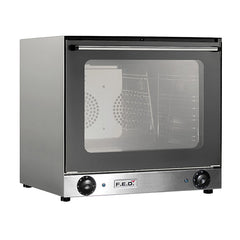There are several different types of ovens available for commercial kitchens, each one cooks in a slightly different way and is used for different types of foods.
 |
Convection Ovens
Convection ovens are the type you find in any residential household. They can be gas or electric and are not very complicated machines. The heat source at the bottom of the oven cabinet cooks food by circulating hot air inside the oven cabinet. This hot air circulation is a natural process, called convection and it can be assisted by internal oven fans. This is the difference between static and fan-forced convection ovens.
Convection ovens are suited for roasting, some baking so can do many dishes from chicken to bread, even some pies and pasties. Convection ovens come in many shapes and sizes to suit your kitchen’s layout. Some are wider, some are deeper, some have GN compatible sized trays and some have bakery or patisserie sized trays for different applications.
Generally pizza shops and bakeries use the larger patisserie or bakery trays (sometimes sized in imperial inches) and also require fridges and freezers with large doors to accommodate the large trays. Other commercial kitchens such as in hotels may require GN sized ovens as their fridges and freezers are also GN (Or gastronorm) size.
Bakery tray size - 400mm x 350mm
Gastronorm Pan size - 530 x 325 mm
Pâtisserie tray size - 400 x 600mm

Combi Ovens
Combi Ovens cook food with steam. Like convection ovens, they are available in many different shapes and sizes, usually referred to by the number of trays they have such as “a 5 tray oven” or “a 10 tray combi”. The advantages of cooking with steam are that it is very precise and very easy to use.
Combi steam ovens can also cook meat, fish and vegetables all at the same time. This is a handy feature on some of the higher end models with many features. Different temperature steam can be applied to different level trays so foods that require different temperatures can be cooked simultaneously. The more feature-packed models have touch screen displays and with minimal training, you can have a kitchen-hand cooking chef-level cuisine in no time.

Impingement
Impingement Ovens like the Matchbox models are the latest technology in the commercial oven world. These ovens use compressed hot air to cook food very accurately. They are also very easy to use, like combi ovens, once the menus are set up.
Matchbox ovens have a cooking surface that looks kind of like a conveyor oven but instead of a conveyor belt rolling, the whole length of the cooking surface rocks from left to right, through the cooking chamber. This cooking action lets the oven manage a wide variety of foods, including pizza, steak, vegetables and a lot more. The Matchbox ovens can even store up to 5,000 menu items, with preset cooking protocols set up by a chef. Once set up, this lets anyone in the kitchen cook any of those dishes at the press of a button. Think about the staffing potential in your business, if one person can now prepare that many menu items, consistently - How much is that worth to your business?
Another huge feature of Matchbox ovens is that they have no need for ventilation or exhaust air removal. These ovens have catalytic converters and other filtration systems built in, which deal with all the exhaust generated by the cooking process. So they take up a lot less space than other types of ovens, can cook a huge variety of dishes accurately and consistently, don’t need any exhaust canopies and can be operated by staff with minimal training... Just think of the possibilities!

Conveyor Ovens
Conveyor Ovens are a staple in pizza shops and have found their way into smaller and smaller cafes and restaurants in recent years, adding variety and profitability to menus. These ovens use a rotating conveyor belt to move food through a cooking chamber, which can be heated from the top and/or bottom. Food moves from one side of the conveyor to the other, getting cooked on the way through. The speed of the conveyor along with the heat of chamber is controlled by the operator. Conveyor ovens are not exclusively for pizza, they can be used for steak, chicken and many other dishes.
Smaller conveyor ovens may have a cooking surface width of 30cm and a length of approximately 1m. These are electric, single phase with digital controllers and go up to a few different sizes. Larger conveyor ovens also come in electric but more commonly are sold as gas units, as gas is a much cheaper energy source than electricity. Depending on the required output, some of these larger ovens can cook several hundred pizzas each hour.
Deck Ovens
Deck Ovens are a type of static convection oven with a stone (hearth) base. These are a type of oven used often in pizza shops. These ovens use a stone base to spread the cooking heat evenly and are the best for getting soft, flakey pastry. Deck ovens, although designed to be an alternative to wood-fired pizza ovens, produce excellent results when cooking pasties, pies and other pastries because unlike other oven types, they cook through the bottom of the food and result in crispy bases.
 |
Oven Ranges
Oven Ranges are the combination cookers with open flame hobs on top and a convection oven underneath. Similar to the small residential type oven/stoves, oven ranges are the commercial equivalents which are generally supplied in Natural Gas or LPG versions however are available in electric models as well.
Oven ranges generally come in two sizes only, 4 burner or 6 burner. 4 Burners up top with an oven underneath is usually 600mm wide and 6 burner versions are usually around 900mm wide. Some suppliers have 8 burner versions which are approx 1200mm wide however it is unlikely that the oven is also that wide.
The advantages of oven ranges are that they can be gas powered and save space by having the open burners (hobs) on top. Some ovens are specifically designed to house a specific number of large size GN pans.
Microwave Ovens
Microwave Ovens may not immediately come to mind when thinking of commercial ovens however they are one of the most underrated and heavily utilized appliances in the modern commercial kitchen.
Commercial Microwave ovens are similar to the one you have at home except that they are a lot more powerful and usually somewhat larger too. Microwave ovens use a magnetron to generate and blast food with microwaves which cause atoms and molecules to jump around ecstatically. This rapid movement on a molecular and atomic level results in heat, thereby warming up your food!
Commercial microwave ovens are supplied in two main sizes/strengths, around 1100w and 1800w. Your household microwave might be around 800 - 900w, so even a small commercial unit will be at least 25% more powerful than a residential version. Microwave ovens are particularly handy when it comes to frozen foods as the excited water molecules heat quickly enough to go from solid ice to gaseous steam very quickly and the steam actually cooks the food, resulting in crunchy, fresh-tasting delicacies!









